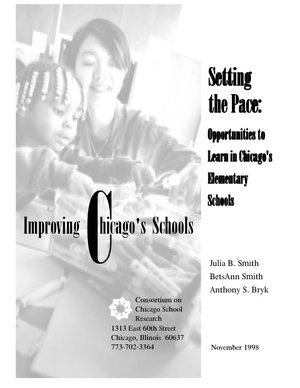During in-depth field studies in Chicago Public Schools (CPS) classrooms, researchers began to notice that similar lessons were being taught to students several grades apart. Concepts such as the definition of a parallelogram were being taught again and again, with little or no development in depth and complexity. Because of the concerns raised by these observations, this study was developed to address the issue of curriculum pacing on a system-wide level. Researchers used survey reports from Chicago teachers on the content they teach their classes in order to examine the prevalence of slow or repetitive pacing and its distribution in Chicago schools. The study focused on math, which is commonly approached as a systematic presentation of topics that build upon prior knowledge and that grow in complexity. The question addressed was: Are CPS students at each grade given the opportunity to learn the concepts for which they are held accountable on standardized tests?
The report finds that while about half of CPS schools maintain grade-level pacing, the other half fall far behind, especially in the upper grades. In addition, pacing problems are most prevalent in predominantly minority and African-American schools, schools with high mobility, and schools with weak professional community. Schools with strong professional community report significantly faster pacing, even among the most disadvantaged schools. These results point to the need to strengthen schools as organizations to keep the curriculum moving forward. In particular, good teacher communication and collaboration play a significant role in coordinating curriculum, both across grades and across classrooms within a grade.
INTRODUCTION
1998 completes an important decade of the CPS's evolving reform movement. The Consortium on School Research has contributed to this process through a series of reports on school improvement and student learning. In this study, we turn our attention to one of the most essential concerns of all: the quality of classroom instruction.
At issue here is a critical concern—the opportunities for Chicago’s children to learn all that is expected of them. We find that while some CPS students experience instruction that keeps pace with grade level expectations and test demands, many do not. Moreover, while some Chicago teachers are working to align their instructional programs across classrooms and grades, others operate under widely different assumptions about what students should know and be able to do. Especially troublesome is the finding that students attending schools in Chicago’s most disadvantaged neighborhoods are much more likely to encounter instruction that is poorly coordinated and that conveys weak expectations for student learning.
Fortunately, there is also good news in this report. We find that some Chicago schools—including some that serve disadvantaged neighborhoods— present their students with a progression of challenging instructional opportunities. In these schools, administrators and teachers are working together to coordinate instructional programs that keep pace with nationally normed expectations for student achievement. Some of the distinctive characteristics of these schools are also identified in this study.

